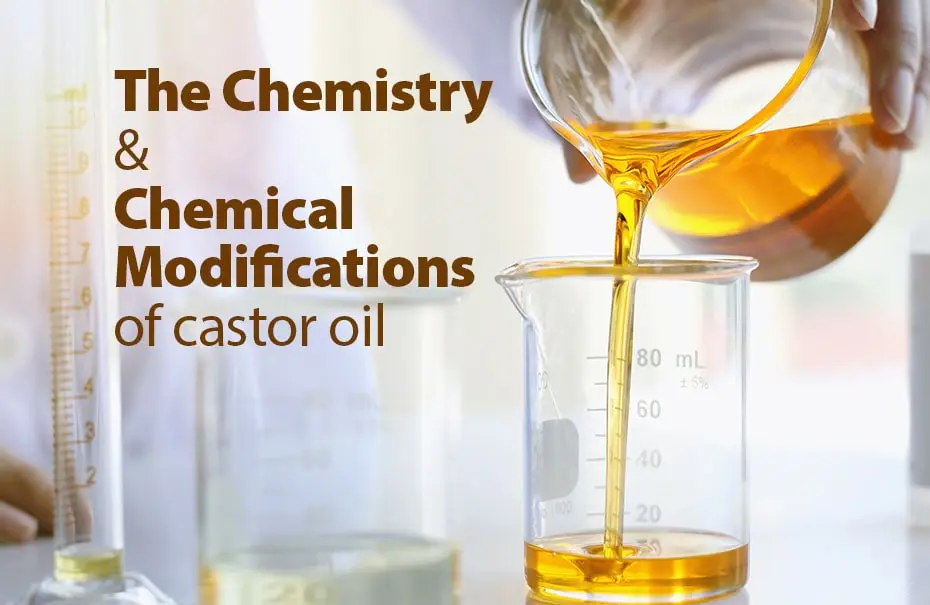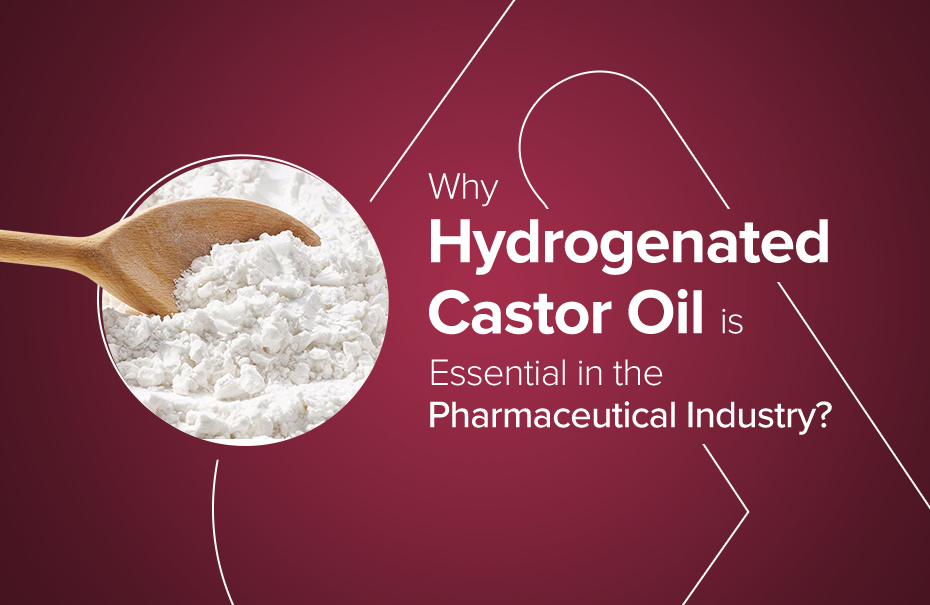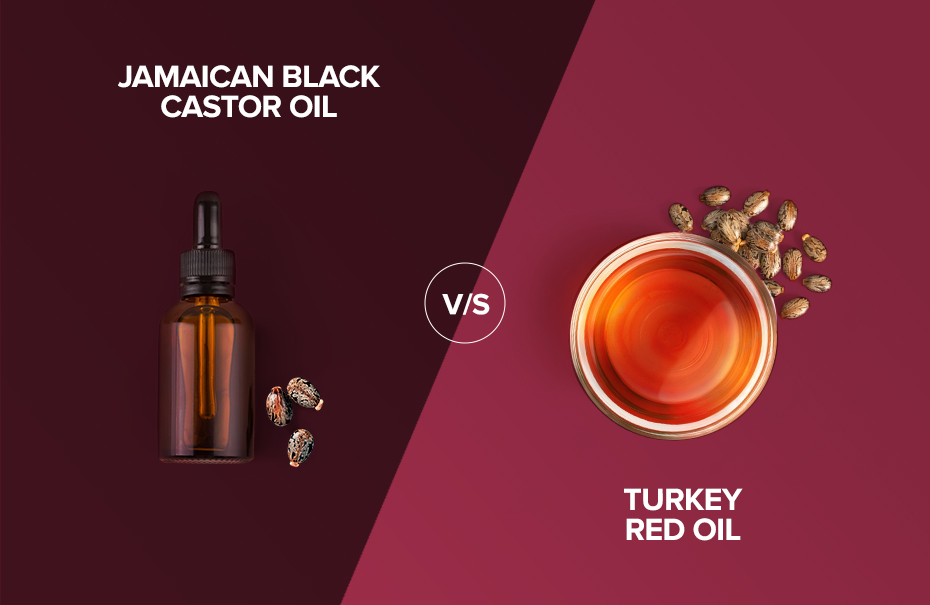The Chemistry & Chemical Modifications of Castor Oil

The more you unearth castor oil’s incredible abilities, the more surprised you will be because this pale-golden oil is no less than a magical oil. Due to its natural chemistry and the chemical modifications that one can do in it, the results you get are jaw-dropping. So, let’s unlock castor oil’s full potential.
Understanding Castor Oil
Castor oil is a name that you can now find in almost every industry sector from skincare and cosmetics, pharmaceuticals, lubricants, and food to agriculture, due to its versatility.
Obtained from the seeds of a castor plant, also known as Ricinus Communis, castor oil is an ancient oil that was the only remedy for almost all health issues then. As times changed and technology advanced, castor oil was pushed back into the corners of the shelves – unused and forgotten due to various aromatic and feel-good alternatives. But, people have started realizing the fact that not everything that glitters is gold and hence are coming back to good-old natural products ditching the attractive yet dangerous chemical products, and among those natural ones is our Castor Oil.
Castor seeds which contain up to 50% of the castor oil are cold-pressed which yields 100% pure castor oil. The castor oil thus obtained is then taken to various industries where they undergo certain chemical processes and result in castor oil derivatives that make up most of the market today. Now, to understand those chemical processes, you must know the composition of castor oil first. So, here it is.
The Chemistry of Castor Oil
Castor oil is made up of all good things. The natural plant oil – Castor contains 85–90% Triglyceride of Ricinoleic acid (a powerful antioxidant with anti-inflammatory properties) and 12 Hydroxy Oleic Acids.
A multitude of useful castor derivatives can be prepared with castor oil because of its unique ester linkages, double bonds, and hydroxyl groups. Among other fatty acids, the unusual composition of ricinoleic acid in castor oil causes it to be more polar than most fats. As a result of its high polar hydroxyl group, castor oil is readily compatible with a broad variety of chemical reactants and can also be converted into a wide range of products known as castor oil derivatives.
Thus, the credit for the distinctive chemical and physical properties of castor oil goes to its ricinoleic structure which allows the modification of its different functional groups such as the hydroxyl group, vinyl group, and ester group.
Now, let’s see what chemical modifications you can do to castor oil.
Chemical Modifications of Castor Oil
A variety of chemical processes can be utilized to manipulate the unique properties of castor oil by exploiting its various functional groups. They are as follows.
Transesterification
A process in which a chemical reaction between an alcohol and an ester present in the castor oil takes place. The glycerol functional group from the triglyceride of castor oil is removed and replaced by alcohol during the process; which is carried out in the presence of a catalyst that can be either an acid or a base but mostly acid catalysts like hydrochloric acid or sulfuric acid are used. Excess alcohol is required during transesterification because the process is reversible and the products formed in this process are glycerol and biodiesel (methyl ricinoleate).
Epoxidation
One of the most beneficial chemical processes because the epoxides obtained from vegetable oils and their alkyl esters have a wide range of applications as well as can be used as intermediates in the production of a variety of derivatives because of the high reactivity of the strained epoxide ring.
To carry out this chemical reaction, usually, a peracid (peroxy acid), either preformed or formed in situ is reacted with a carboxylic acid (usually acetic acid) as an oxygen carrier with hydrogen peroxide (H2O2) as an oxygen donor. The process is adaptable because different kinds of catalysts both biological and inorganic are used for epoxidation and the products obtained are known as oxirane compounds or epoxides. Epoxidized castor oil obtained thus is used in high-temperature lubricants, polyurethane dispersions, paints, coatings and adhesives, nanocomposites, surfactants, hydraulic oils, and biodiesel.
Bio Binders
Also known as biopolymers, bio-binders are compounds obtained from natural resources such as plants and contain monomers that are linked by covalent bonds to form polymeric chains. Due to the distinctive composition of castor oil, castor oil-based bio-binders have made their way to multiple industries for different applications in the form of polyurethanes, polyamides, polyethers, and polyesters.
Bio-binders
Act as glue for combining different materials and differ in terms of their properties such as density which is considered to be one of the most important properties as it determines where the binder will be applicable. Other than that, they are differentiated according to their mechanical and engineering properties like tensile strength and modulus, vapor transmission characteristics, melt flow indices, impact properties, flexural strength and modulus, hardness, coefficient of friction, elongation, and decomposition.
Ozonolysis
The only oxidative cleavage method that can be carried out at low temperatures (25°C–45°C) without a catalyst and the decomposition occurs at 60°C–100°C.
Ozonolysis of vegetable oils like castor oil is conducted for the synthesis of polyols with almost three hydroxyl groups per molecule. Using ozone as a strong oxidizing agent, the ozonolysis procedure is applied to castor oil to cleave and oxidize alkenes which are then reduced to alcohols using a strong reducing agent such as sodium borohydride (NaBH4).
Dehydration
Although classified as a non-drying oil, castor can be dehydrated to give semi-drying or drying oil which is used extensively in paints and varnishes. For dehydration, the major component of the castor oil – Ricinoleic acid is reacted with sulfuric acid or phosphoric acid, which acts as a catalyst, to reduce and remove its hydroxyl group with a vinyl group.
Sulfation
Known to be the first chemical derivative of castor oil, sulfated castor oil even has a popular name – Turkey Red Oil due to the sulfur reddish color of it. Used extensively in textile and cosmetics industries, sulfated castor oil is obtained via the sulfation process in which concentrated sulfuric acid is added at the same rate to castor oil for a few hours with constant cooling and agitation at 25°C–30°C. As soon as the reaction is complete, the product is neutralized using a base solution or an amine. The entire process takes about 3 to 4 hours and is done at room temperature.
Pyrolysis
A thermal method that converts biomass to solid, liquid, and gaseous fuels in the absence of oxygen is called pyrolysis. Pyrolysis of castor oil is done at 350°C for approximately 30 min during which its molecule splits into undecylenic acid and heptaldehyde.
Hydrogenation
The very famous hydrogenated castor oil is obtained by the hydrogenation process which involves the introduction of a hydrogen atom to the unsaturated fatty acid in the presence of a catalyst (e.g. nickel or palladium). The hydrogen then reacts with the ricinoleic acid present in castor oil and yields a saturated 12-hydroxystearic acid that is semi-solid in nature which is highly used in the industry for polymer materials because of enhanced thermal, oxidative stability, optimum tensile strength, elongation at break, and the resistance of rubber to swelling.
Hydrolysis
Another famous derivative of castor oil – Sebacic acid – used as a monomer for the synthesis of nylon, is obtained by carrying out a hydrolysis process in which castor oil is added slowly to 80 % caustic solution (sodium hydroxide) at approximately 250°C–360°C the result of which is the formation of glycerol and ricinoleic acid which are then further heated at 523 K in the presence of NaOH to produce capryl alcohol (2-octanol) and sebacic acid (a 10 carbon dicarboxylic acid).
Surprised?
Isn’t it shocking how a single oil gives a wide variety of other products due to which multiple industry sectors are running and growing? Castor oil is indeed an incredible oil and the properties it carries are worth exploring. We at Ambuja Solvex produce 100% pure castor oil and we hope our precious oil unlocks many more possibilities in the future.



